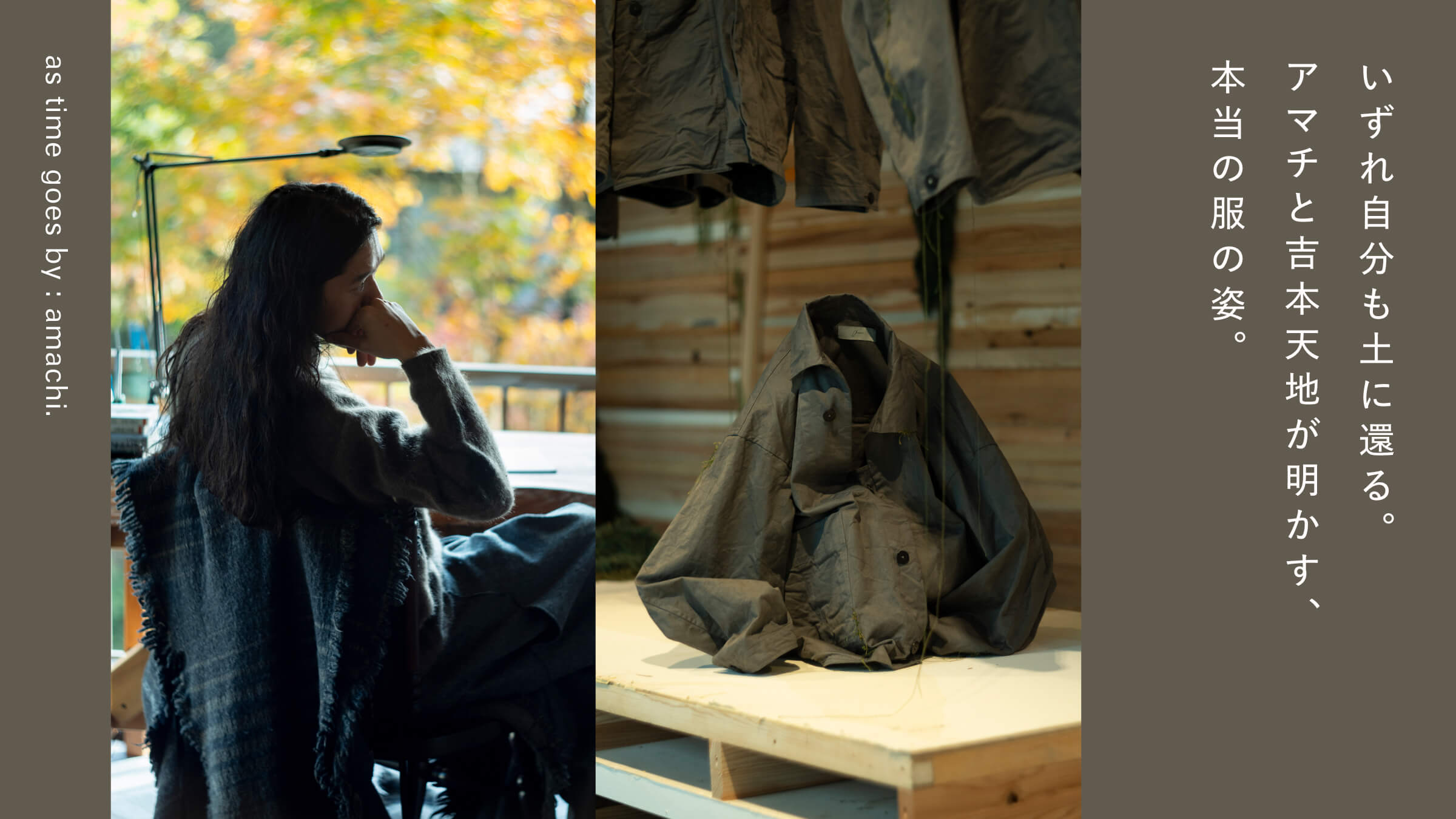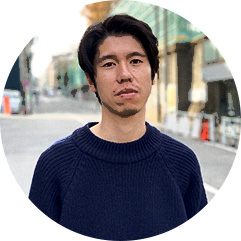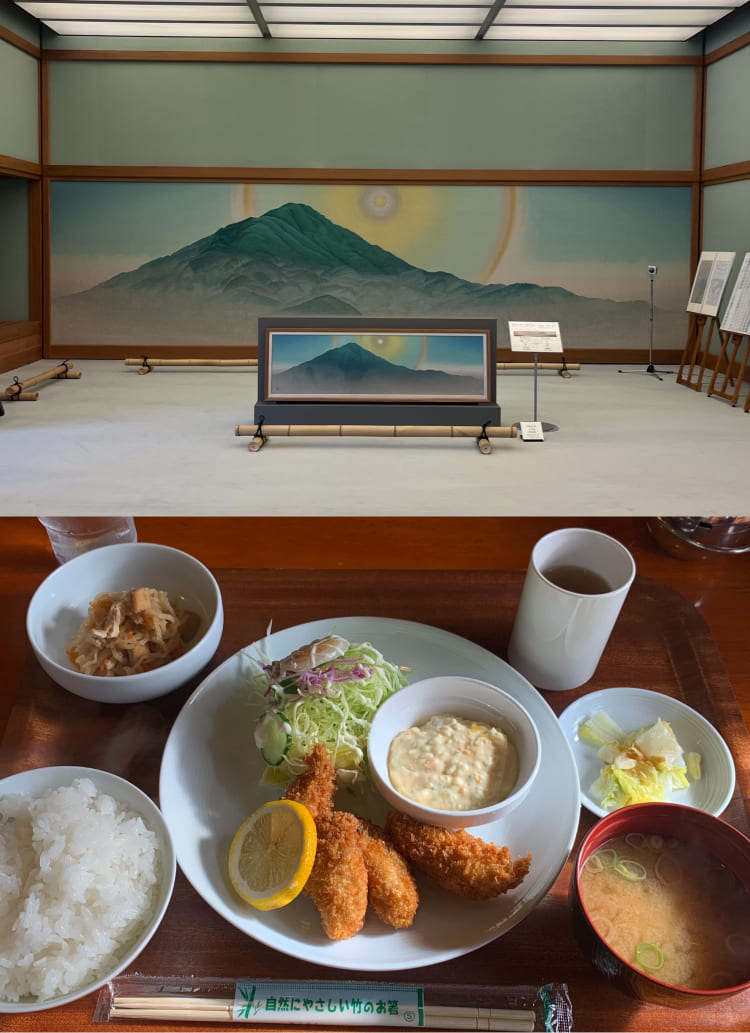
PROFILE
Born in the U.S. in 1993 and raised in Elk Valley, Northern California until the age of 8. 2000, moved to Japan with his family. He started his own brand, Amachi, at the age of 23, after gaining experience making clothes from the age of 18. In 2009, he was in charge of space design for a new exhibition at the Aichi Prefectural Museum of Art's "Ghibli Grand Exposition.
A new base and memories of faraway places.
It takes about three hours by car from Tokyo. It is known as one of the most nature-rich areas in Nagano, and when we visited at the end of October, the autumn leaves were just at their best. Amachi's atelier is located in the middle of a forest, and the area is so quiet that the chirping of birds echoes through the air. Wild animals such as deer, wild boars, and momonga (flying squirrel) are said to appear in the hills behind the studio.
I go to the back of the mountain in the morning or evening. It's part of my daily routine, and walking helps me to clear my mind.


He sometimes goes to the backwoods to look for sources of inspiration for his clothing creations.
Amachi moved its workspace here from the prefecture last June. Yoshimoto cited a change in the way clothes are made as the reason for the move.
What used to be a concrete motif has recently become an abstract concept. The theme of this fall/winter collection, "Decomposition," is symbolic of this. I don't have a strong preference for places, but I have always been easily influenced by where I live, so I try to consciously choose environments that fit my skin.


The atelier is surrounded by abundant nature. Light pours into the living room.
Yoshimoto was born in Elk Valley, a mountainous region in Northern California, USA. Because it is an extremely local area with no social infrastructure, even if you Google the name of the place, you will not be able to find any information about it.
No one is there anymore." We were the last ones there. It started out as a place for Japanese potters to make pottery, and gradually various artists gathered there and it became a small community. My father, who was at the center of the hippie culture in Japan at the time, connected with Allen Ginsberg, Gary Snyder, and others, and before I was born, we moved our base there.

Yoshimoto's desk with autumn leaves spreading out before him.
In a place with no electricity, gas, or running water, Yoshimoto's parents built their own house, cultivated their own fields, made their own clothes, and lived an almost self-sufficient life.
I was born at home, not in a hospital. Now that I think about it, I used to live in that place while raising my children, and in a way, I think that was for my own good."
His parents gave him the name "Heaven and Earth," meaning that he is the link between heaven and earth.
The name is also the name of an artist that my parents were working with before I was born. I had no hesitation in using it as the name of my brand. The relationship between nature and humans is an important keyword for Amachi. The name is connected to what we want to convey through our clothes.

The name tag was designed with Yoshimoto's signature.
At night, they would sleep outside while gazing at the stars. During the day, he would pick up stones and make necklaces. Yoshimoto spent eight years in an environment where everything was connected to nature.
I am sure that my roots are in that place, and I still have illusions about it. When I went back there for the first time in 14 years, it was very strange to see the house still there. I found my mother's violin lying around. I felt as if I had wandered into my own memories.

An axe in the mold of a torso. Different combinations are on the terrace.
Childhood memories had a great influence on Yoshimoto's personality development, which was linked to what he wanted to express in his clothes making.
People sometimes think that Amachi imitates nature, but that is only superficial. There is a depth to our work that cannot be imitated by natural objects, and we are trying to see how far we can go with the presence and fabrics of our clothes. But what I really want to convey is something deeper, something spiritual.


The Icelandic stone was attracted by the beauty of lichen. The other is volcanic glass of mysterious colors.
Certainly, the medium of fashion has the aspect of uplifting the wearer's mood by stimulating his or her mind. From a broader perspective, we may be using clothing as a window to society.
The wearer may or may not be conscious of it, but just as we are influenced by the places where we usually go, we are unconsciously influenced by the clothes we wear. The first step may be to say, "I like this shape," or "I want to be fashionable. I believe that being influenced will change one's consciousness, and this will lead to changes in society. That should be a positive influence, and that is the kind of clothing I want to make.


Up to three staff members work in the atelier. The vases were custom ordered by ceramicist Elise Jetrifi for the installation of the collection.
What we are trying to do is nothing special. Yoshimoto understands that "amachi" exists within the larger framework of contemporary fashion.
I think it is important to understand the context of fashion and to keep a critical eye on one's own expression, as well as to present new pieces each season. It can be easy to stray from that. When I was a child, I was surrounded by many people who were involved in underground activities. But I am sure that there are things that can only be seen by coming into contact with the world from a broader perspective."

Yoshimoto was also influenced by his grandfather, who was a university professor. His grandfather was a bookworm and bought dozens of books a month.
If you notice, this is the ninth year for the brand, which started in 2017. The collection is now in its 15th season for fall/winter 2024.
When I started Amachi, I moved my base of operations from Tokyo to Nagano in order to solidify the core of my business without being influenced by others. I was determined to succeed. However, in my haste, some things were left out, so I am now in the process of reconstructing the foundation of what I want to do.
As one gets older and more experienced, one naturally develops equations for solving problems. Yoshimoto, too, says that he has found, to a certain extent, the correct solution to "Amachi" through his accumulated experience.
I've been doing this for eight years, I know who will wear my clothes, and I have a good idea of where I want my designs to fall, but I need to throw that away.

What we are looking forward to after scaling up is overseas expansion, which we have halted up to now.
The scale of the brand is still small, but some stores and regions in Japan have been penetrated through close communication with the people who sell our products over time. I feel that now is the right time to expand this way of distribution that we have carefully built. In fact, we receive more contacts from overseas through SNS. We have already begun to distribute in Belgium and South Korea, and in the United States in the spring. I am looking forward to seeing how Amachi will be accepted around the world.









